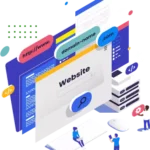So, you’ve got an idea bubbling in your brain, a message to share with the world, or a business yearning for an online presence. Fantastic! But before you dive headfirst into the world of web design, it’s crucial to gather the essential tools and knowledge. Think of it like embarking on an exciting road trip – you wouldn’t leave without a map, snacks, and a reliable vehicle, right? This blog post serves as your comprehensive roadmap, guiding you through the key ingredients needed to design a website that wows.
Step 1: Charting Your Course – Defining Your Goals and Target Audience
Before unleashing your creative spirit, take a moment to reflect on your website’s purpose. What do you want to achieve? Is it to sell products, showcase your portfolio, or simply connect with like-minded individuals? A clear understanding of your goals acts as your compass, guiding design decisions and ensuring your website resonates with the right audience.
Next, identify your target audience. Who are you trying to reach? Understanding their demographics, interests, and online behavior will help you tailor the website’s tone, style, and content to their preferences. Imagine building a bridge – you design the access points based on who needs to cross it.
Step 2: Laying the Foundation – Choosing the Right Tools and Platform
Now that you know your destination and passengers, it’s time to pick your chariot. Here are the crucial elements for laying a solid foundation:
- Domain Name: This is your website’s unique address on the internet, your virtual storefront’s sign. Choose a name that’s memorable, relevant to your brand, and easy to spell.
- Web Hosting: Think of this as the rented space where your website’s files reside, accessible to visitors worldwide. Choose a reliable hosting provider with features that match your website’s needs.
- Website Builder/Content Management System (CMS): This is your website’s construction kit, allowing you to build and manage its content. For beginners, user-friendly website builders like Wix or Squarespace offer drag-and-drop interfaces and pre-designed templates. More experienced users might opt for open-source CMS platforms like WordPress for greater flexibility and customization.
Step 3: Building the Architecture – Structuring Your Website
With the foundation laid, it’s time to design the blueprint of your website. Information architecture refers to how you organize your content and pages, making it easy for users to navigate and find what they’re looking for. Here are some key elements:
- Sitemap: This visual representation of your website’s structure acts as a roadmap for both users and search engines.
- Navigation: Design clear and intuitive menus that allow users to effortlessly explore different sections. Think drop-down menus, breadcrumbs, and search bars for added convenience.
- Wireframing: Create low-fidelity sketches of your page layouts to visualize the hierarchy of information and user flow before diving into design.
Step 4: Painting the Picture – Design Principles and User Experience (UX)
Now comes the fun part – dressing up your website! But remember, aesthetics go hand-in-hand with functionality. Here are some design principles to keep in mind:
- Simplicity is key: Avoid clutter and overwhelming users with too much information or visual elements.
- Visual hierarchy: Use elements like size, color, and contrast to guide users’ eyes towards important information.
- Responsiveness: Ensure your website adapts seamlessly to different screen sizes and devices, providing an optimal experience for everyone.
- Accessibility: Make your website accessible to users with disabilities by following WCAG guidelines, ensuring everyone can access your content.
Remember, UX is paramount. Consider how users interact with your website, anticipating their needs and making their journey smooth and intuitive. Test your design with real users to gather feedback and iterate based on their experiences.
Step 5: Filling the Shelves – Content is King
With a stunning design in place, it’s time to stock your website’s shelves with engaging content. Remember, high-quality, informative, and relevant content is what keeps users coming back for more. Here are some content essentials:
- Compelling copy: Write clear, concise, and engaging text that resonates with your target audience.
- Visually appealing images and videos: Break up text with relevant visuals that enhance your message and grab attention.
- Calls to action (CTAs): Tell users what you want them to do next, whether it’s subscribing to your newsletter, purchasing a product, or contacting you.
- SEO optimization: Optimize your website’s content and structure for search engines to increase its visibility in search results.
Step 6: Grand Opening – Launching and Maintaining Your Website
Congratulations! You’ve built your website from the ground










